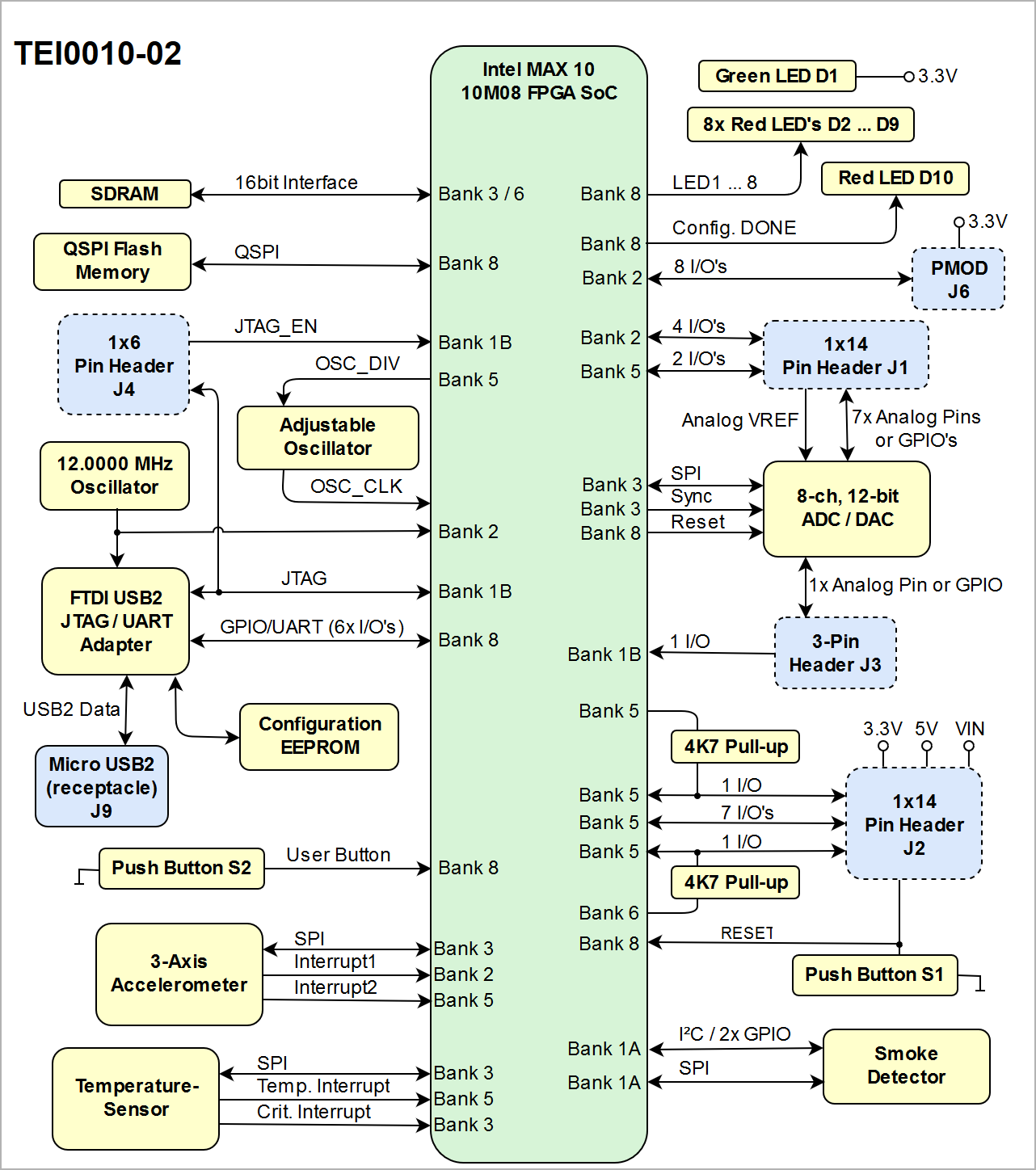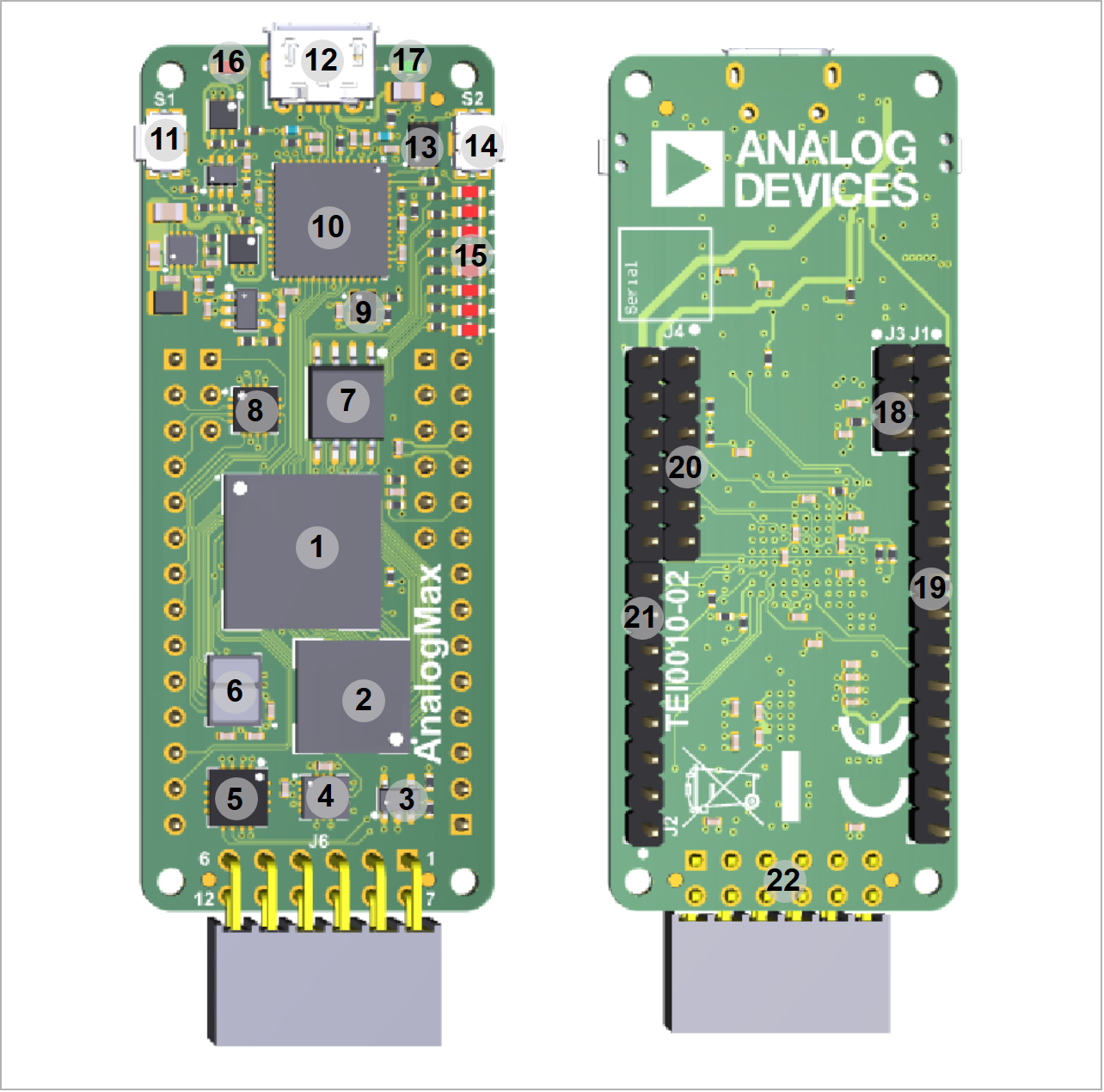Template Revision 2.2 - on construction TRM Name always "TE Series Name" +TRM, for example "TE0720 TRM" |
<!-- tables have all same width (web max 1200px and pdf full page(640px), flexible width or fix width on menu for single column can be used as before) -->
<style>
.wrapped{
width: 100% !important;
max-width: 1200px !important;
}
</style> |
----------------------------------------------------------------------- |
Note for Download Link of the Scroll ignore macro: |
Table of Contents 
|
Overview
The Trenz Electronic TEI0010 AnalogMax is a low cost small-sized FPGA module integrating an Intel MAX 10 FPGA SoC, 8 MByte serial memory for configuration and operation and 8 MByte SDRAM. The board is equipped with several sensors for analog values like a 3-axis accelerometer, temperature sensor, smoke detector and a 8-channel 12bit ADC/DAC.
Refer to http://trenz.org/analogmax-info for the current online version of this manual and other available documentation.
Key Features
Notes : - List of key features of the PCB
|
Intel MAX 10 10M08 FPGA SoC
- 8 MByte SDRAM
8 MByte QSPI Flash memory
- Onboard oscillator with 3 selectable frequencies
- Analog Devices ADXL362BCCZ MEMS 3-axis accelerometer
- Analog Devices ADT7320UCPZ temperature sensor
- Analog Devices ADPD188BI smoke detector
- Analog Devices AD5592RBCPZ ADC/DAC
- JTAG and UART over Micro USB2 connector
- 1x6 pin header for JTAG access to FPGA SoC
- 1x PMOD header providing 8 GPIOs
2x 14-pin headers (2,54 mm pitch) providing 22 GPIOs with 7 analog inputs as alternative function
- 1x 3-pin header providing 2 analog inputs or 1 GPIO
8x user LEDs
- 1x user push button
- 5.0V single power supply with on-board voltage regulators
- Size: 61.5 x 25 mm
Block Diagram
Main Components
Notes : - Picture of the PCB (top and bottom side) with labels of important components
- Add List below
|
- Intel MAX 10 10M08 FPGA SoC, U1
- 8 Mbyte SDRAM 166MHz, U2
- LT LTC1799 oscillator, U10
- Analog Devices ADXL362BCCZ MEMS 3-axis accelerometer, U11
- Analog Devices ADT7320UCPZ temperature sensor, U8
- Analog Devices ADPD188BI smoke detector, U14
- Winbond W74M64FV QSPI Flash memory, U5
- Analog Devices AD5592RBCPZ ADC/DAC, U12
- 12.0000 MHz MEMS oscillator, U7
- FTDI USB2 to JTAG/UART adapter, U3
- Push button (reset), S1
- Micro USB2 B socket (receptacle), J9
- Configuration EEPROM for FTDI chip, U9
- Push button (user), S2
- 8x red user LEDs, D2 ... D9
- Red LED (Conf. DONE), D10
- Green LED (indicating 3.3V supply voltage), D1
- 3-pin header (2.54mm pitch), J3
- 1x14 pin header (2.54mm pitch), J1
- 1x6 pin header (2.54mm pitch), J4
- 1x14 pin header (2.54mm pitch), J2
- 2x6 Pmod connector, J6
Initial Delivery State

Storage device name | Content | Notes |
|---|
| Quad SPI Flash, U5 | DEMO Design | - | | FTDI chip configuration EEPROM, U9 | Programmed | - |
|
Control Signals
- Overview of Boot Mode, Reset, Enables,
|
To get started with TEI0010 board, some basic signals are essential and are described in the following table:

Control signal | Switch / Button / LED / Pin | Signal Schematic Names | Connected to | Functionality | Notes |
|---|
| MAX10 FPGA U1 JTAGEN | header J4, pin 2 | JTAGEN | MAX10 FPGA U1, bank 1B, pin E5 | high: MAX 10 JTAG enabled,
floating: MAX 10 JTAG disabled | switch the JTAG pins to user GPIO's if drive this pin to GND | | MAX10 FPGA U1 Reset | header J2, pin 10 | RESET | MAX10 FPGA U1, bank 8, pin E7 | low active reset line | also connected to Reset push button S1 | | Supply voltage indicator | Green LED D1 | 3.3V | DCDC U4 | indicating 3.3V voltage level | - | | Configuration DONE indicator | Red LED D10 | CONF_DONE | MAX10 FPGA U1, bank 8, pin C5 | indicating FPGA configuration completed | ON: configuration completed, OFF: FPGA not configured | | Reset Push button | S1 | RESET | MAX10 FPGA U1, bank 8, pin E7 | low active logic | - | | User Push button | S2 | USER_BTN | MAX10 FPGA U1, bank 8, pin E6 | low active logic | available to user |
|
Boot Process
The FPGA configuration for Intel MAX 10 FPGAs can be stored through JTAG interface either in external configuration device (QSPI flash memory U5) or on the FPGA itself since the Intel MAX 10 FPGA offers non-volatile memory on chip. The FPGA configuration is loaded from the non-volatile memory when the board is powered up.
To configure the FPGA directly, the JTAG interface can be used to configure the FPGA volatile, means the configuration is lost after power off.
Signals, Interfaces and Pins
Notes : - For carrier or stand-alone boards use subsection for every connector typ (add designator on description, not on the subsection title), for example:
- For modules which needs carrier us only classes and refer to B2B connector if more than one is used, for example
|
I/Os on Pin Headers and Connectors
I/O signals of the FPGA SoC's I/O banks connected to the board's pin headers and connectors:

| Bank | Connector Designator | I/O Signal Count | Bank Voltage | Notes |
|---|
| 2 | J1 | 4 I/O's | 3.3V | - | | J6 | 8 I/O's | Pmod connector | | 5 | J1 | 2 I/O's | 3.3V | - | | J2 | 9 I/O's | 2 I/O's of bank 5 can be pulled-up to 3.3V (4K7 resistors) | | 1B | J4 | JTAG interface and 'JTAGEN' signal (5 I/O's) | 3.3V | JTAG enable signal (JTAGEN) on pin J4-2, switch between user I/O pins and JTAG pin functions | | J3 | 1 I/O | - |
|
FPGA I/O banks
Table below contains the signals and interfaces of the FPGA banks connected to pins and peripherals of the board:

| Bank | I/O's Count | Connected to | Notes |
|---|
| 2 | 4 | 1x14 pin header, J1 | user GPIO's | | 8 | Pmod connector, J6 | user GPIO's | | 1 | clock oscillator, U7 | 12.0000 MHz reference clock input | | 1 | reference clock oscillator, U10 | reference clock input from oscillator U10 | | 1 | accelerometer IC, U11 | interrupt 1 line of Analog Devices MEMS accelerometer | | 5 | 9 | 1x14 pin header, J2 | 2 I/O's (D11, D12) of bank 5 can be pulled-up to 3.3V (4K7 resistors) with 1 I/O (D12_R) of same Bank and 1 I/O (D11_R) of bank 6 | | 1 | accelerometer IC, U11 | interrupt 2 line of Analog Devices MEMS accelerometer | | 1 | reference clock oscillator, U10 | oscillator adjustable with three steps of clock output | | 1 | temperature sensor IC, U8 | interrupt line of temperature thresholds | | 6 | 18 | 8 MByte SDRAM 166MHz, U2 | 16bit SDRAM memory interface | | 3 | 22 | 8 MByte SDRAM 166MHz, U2 | 16bit SDRAM memory interface | | 3 | SPI interface connected to IC U8, U11, U12 | SPI interface (MISO, MOSI, MCLK) for temperature sensor U8, 3-axis accelerometer U11 and ADC/DAC U12 | | 1 | temperature sensor IC, U8 | chip-select line for SPI interface | | 1 | accelerometer IC, U11 | chip-select line for SPI interface | | 1 | ADC/DAC IC , U12 | Synchronization line of ACD/DAC IC (active low control input) | | 1 | temperature sensor IC, U8 | interrupt line of critical temperature | | 1A | 8 | 1x14 pin headers J1 | 7 analog inputs or GPIO's, 1 pin analog reference voltage input | | 2 | pin headers J1 | 1 analog inputs or GPIO, 1 dedicated analog input | | 1B | 5 | pin header J4 | 4 I/O's JTAG interface and 1x 'JTAGEN' signal to switch the JTAG pins to user GPIO's if drive this pin to GND | | 8 | 8 | LEDs D2 ... D9 | Red user LEDs | | 6 | QSPI Flash memory, U5 | 6 pins Quad SPI interface, 2 of them pulled up as configuration pins during initialization | | 6 | FTDI FT2232H JTAG/UART adapter, U3 | 6 pins configurable as GPIO/UART or other serial interfaces | | 1 | Red LED, D10 | Configuration DONE Led (ON when configuration in progress, OFF when configuration is done) | | 1 | User button S2 | user configurable | | 1 | Reset button S1 and pin J2-10 | low active reset line for FPGA reconfiguration |
|
On-board Peripherals
Notes : - add subsection for every component which is important for design, for example:
- Ethernet PHY
- USB PHY
- Programmable Clock Generator
- Oscillators
- eMMCs
- RTC
- FTDI
- ...
- DIP-Switches
- Buttons
- LEDs
|
Subsections...
Power and Power-On Sequence
Power Consumption
Power Distribution Dependencies
image link to the generate drawIO PNG file of this page. This is a workaround until scroll pdf export bug is fixed |
|
Power-On Sequence
Create DrawIO object here: Attention if you copy from other page, objects are only linked. |
image link to the generate DrawIO PNG file of this page. This is a workaround until scroll pdf export bug is fixed |
|
Voltage Monitor Circuit
Power Rails
Bank Voltages
Board to Board Connectors
- This section is optional and only for modules.
- use "include page" macro and link to the general B2B connector page of the module series, for example: 4 x 5 SoM LSHM B2B Connectors

|
Technical Specifications
Absolute Maximum Ratings

| Parameter | Min | Max | Units | Reference Document |
|---|
|
|
|
|
|
|
|
|
|
|
|
Recommended Operating Conditions

| Parameter | Min | Max | Units | Reference Document |
|---|
|
|
|
|
|
|
|
|
|
|
|
Physical Dimensions
Variants Currently In Production
Revision History
Hardware Revision History

| Date | Revision | Note | PCN | Documentation Link |
|---|
| - | 01 | Prototypes | - | - |
|
|
|
|
|
|
Document Change History
- Note this list must be only updated, if the document is online on public doc!
- It's semi automatically, so do following
Add new row below first Copy "Page Information Macro(date)" Macro-Preview, Metadata Version number, Author Name and description to the empty row. Important Revision number must be the same as the Wiki document revision number Update Metadata = "Page Information Macro (current-version)" Preview+1 and add Author and change description. --> this point is will be deleted on newer pdf export template - Metadata is only used of compatibility of older exports
|

| Date | Revision | Contributor | Description |
|---|

| | 
| |
|
Disclaimer



